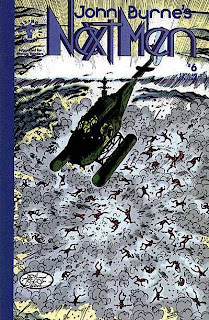John Byrne influenced a generation of comic book artists. In the 1990s, after bouncing between Marvel and DC for over a decade, he turned a proposal for Marvel's 2099 line into 2112, a graphic novel that became the basis for Next Men. This was the issue that tied those two together because after reading 2112 and John Byrne's Next Men #0-5, it was not apparent that they were linked in any way except that both had a character named Sathanas, which could or could not be the same. They certainly didn't look alike. Then this issue was published.
JOHN BYRNE'S NEXT MEN #6
July 1992 - Dark Horse ComicsStory and Art: John Byrne
Colorist: Matt Webb
SYNOPSIS:
In an Antarctic research station, an earthquake rocks four scientists who quickly deduce it came from an explosion 30 miles away. They investigate to discover around a hundred mangled, mutilated, and not-quite-human bodies at the site. One of them is alive, and it quickly attacks the group draining each member's life force to save itself. Recognizing one of the scientists as Fleming Jorgenson, the creature, horribly injured, relishes in that the year is 1955.Cut to the United States and the home of Congressman Aldus Hilltop, who is hosting Dr. Jorgenson, who returned from an apparent explosion of the research station that killed all other scientists there. Aldus Hilltop places his political career above all else. Jorgenson has had Hilltop help retrieve a case from Antarctica in the most confusing and complicated way possible. Inside the crate is the creature he discovered in Antarctica. Named Sathanas, the being is an energy vampire that awakes and brings Hilltop into his grand plan with the promise of power.
Hilltop starts a program with Jorgensen while providing Sathanas with young women to feed off, including Hilltop's own young wife. They are undetected because their corpses resemble old women after Sathanas feeds off them. Jorgensen and Hilltop's program buys infants from teen mothers to mutate into deadly and powerful soldiers. Jorgensen disagrees with the military direction of the project that he and Hilltop have directed under Sathanas's instructions, using historical knowledge to shepherd the project around the chaos of many historic administrations. When Jorgensen makes a veiled threat to give the secrets to another government, he dies in a car accident, which Hilltop had nothing to do with, to the surprise of those around him.
The subconscious education network the test subjects are hooked to has developed a "feedback" that has the test subjects seemingly talking to each other and living in an imaginary reality while training for a life as soldiers. When asked about it, Sathanas confesses that not only will the project produce soldiers, but that they will be well educated and well rounded. He assures Hilltop that in twenty years, the project will succeed, and Hilltop will be President of the United States, confessing that what Hilltop thinks is the future is all in the past for Sathanas.
REVIEW:
This issue is the only one of this series to stand alone. One of the challenges of this series was that John Byrne was telling a larger story. However, this story gives the reader a complete sense of the level of villains the Next Men will face. Sathanas is a patient schemer, willing to sit behind the scenes for the larger plan to unfold. If there is one fault to the story, it covers so long a period that it seems a bit jumpy.
Hilltop is so centered on his self-interests that his methods can only be described as Machiavellian. At one point, he exhibits racial prejudice, which is one extra thing that's unnecessary to establish Hilltop's evil nature. He has already fed at least two wives/lovers to Sathanas and manipulated a eugenics program that would make the Nazis envious. Later in the series, Byrne would add other elements to Hilltop's evil nature, but there is enough here to let the reader know that Aldus Hilltop does not have a redeemable bone in his body.
John Byrne's art is sometimes sketchy and betrayed by the colors from a more primitive computerized coloring process. One cannot fault the craftsmanship in Byrne's ability to repeatedly draw the same character, making them instantly recognizable even though they age by decades. Aldus Hilltop at the end of the book is the same Aldus Hilltop from the beginning, but with all the attributes that come with age. Byrne's layouts are easy to follow. Even using relatively large panels, he manages to tell a lot of information here. The appeal of John Byrne's art style is a personal preference, but one can't find fault in the merits of craftsmanship.




